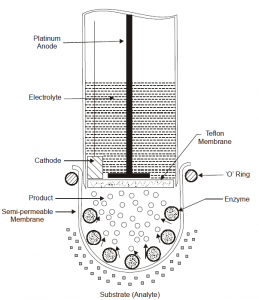Types of Electrodes
Biosensors invariably employ two distinct types of electrodes, such as :
(a) Electrochemical electrodes, and
(b) Microbial electrodes.
These two specialized variants of electrodes shall now be treated individually in the sections that follow:
Electrochemical Electrodes [Enzymes Electrodes]
Electrochemical electrodes (or Enzyme electrodes) are a new type of detector or biosensor that have been exclusively designed for the potentiometric or amperometric assay of substrates, for instance: alcohol, amino acids, glucose, and lactic acid.

Fig. above illustrates the specific design of the electrochemical electrode which is essentially composed of a given electrochemical sensor in close contact with a thin-permeable enzyme membrane that is capable of interacting specifically with the given substrates. Interestingly, the embedded enzymes strategically located in the membrane produce H+ ions, oxygen (O2), NH4+ ions, carbon dioxide (CO2), or ever other small molecules depending solely on the enzymatic reactions taking place, that are rapidly detected by the particular sensor meticulously. Besides, the magnitude of the response gives precise estimations of the prevailing concentration of the substrate.
Nevertheless, the biological component present in a biosensor may invariably be an enzyme or a multi-enzyme system, which could also be an antibody or organelle or microbial cell or even whole slices of tissue.
Microbial Electrodes
Microbial electrodes (biosensors) have been designed meticulously for the estimation of glucose, lactic acid, acetic acid, and assimilable carbohydrates (sugars). A microbial sensor (electrode) essentially comprises a microorganism immobilized membrane (or bacterial collagen membrane) and a pair of electrodes (viz., Lead-anode; and Platinum-Cathode). In fact, several types of sophisticated microbial electrodes have been duly developed, tested, and applied skilfully to the precise measurements of biological substances.
Principle: The underlying principle of a microbial electrode (or sensor) is entirely based upon the fact whether the change in respiration or the quantum of produced metabolites does exert any effect on the ensuing assimilation of substrates by the prevailing microorganisms. Besides, the meaningful application of auxotrophic mutants* may also selectively help in the assay of a wide spectrum of substances.
Examples: Design of vitamin B12 sensor by making use of immobilized Escherichia coli-215. The E. coli-215 strain specifically needs vitamin B12 for its usual normal growth. A linear relationship between these two factors i.e., vitamin B12 and normal growth, was duly obtained between the range 5 × 109 to 25 × 109 ng. mL-1. It has been observed that there existed a small decrease to the extent of only 8% after a duration of 25 days.
Microbial Electrodes Using Thermophilic Organisms: In the recent past microbial electrodes (sensors) based on the usage of specific thermophilic organisms have been duly developed. Probably the usage of thermophilic organisms may minimize the scope of contamination of other microorganisms by using high temperatures to obtain long-term stability.
Examples: BOD and CO2 Biosensors: These biosensors are meticulously prepared by making use of specific thermophilic organisms isolated from hot springs. However, one may obtain a good linear relationship as indicated below :
BOD-Biosensor: BOD-Biosensor response and BOD-value ranged between 1-10 mg. L– 1 BOD at 50°C. Sensor signal was found to be fairly stable and reproducible for up to 40 days at a stretch.
CO2-Biosensor: Linear relationship was duly obtained in NaHCO3 concentration varying between 1 to 8 mg . L– 1 at 50°C, which lasted up to 10 min. However, the linear relationship prevailed in the CO2-concentration. range varying between 3 to 8%.
Advantages: The microbial electrodes (or biosensors) have the following cardinal advantages:
(a) Maybe implanted in the human body, and also found to be absolutely suitable and feasible to in vivo measurements,
(b) Can be skilfully integrated onto ‘one chip’ only, and are observed to be useful for the precise measurements of a host of substrates preferably in a small quantum of sample solution almost simultaneously, and
(c) With the advent of ‘semiconductor fabrication technology in microbial biosensors, it is now quite convenient and possible to develop disposable transducers for biosensors via mass production.

